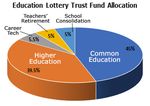Education Lottery Hits Milestones in 2021
←
→
Page content transcription
If your browser does not render page correctly, please read the page content below
State Auditor & Inspector Cindy Byrd
April 2021
Education Lottery Hits Milestones in 2021
A question we hear a lot is “where is all the lottery money for education?” The short
answer is that it’s deposited every month to help fund education. The graphic
below has the breakdown of the Education Lottery Trust Fund allocation:
The Oklahoma
Education Lottery
marked its 16th year in
operation by passing
the billion-dollar mark
with contributions
totaling $1,039,861,645
since approved by 65
percent of voters in
November 2004.
Oklahoma Lottery
Commission Executive
Director Jay Finks notes
that’s a billion dollars in
education funding over
the years that probably
would not have been
available if not for the lottery.
“Our team has worked hard to help make a difference for education across the
State,” Finks said. “Hitting the one-billion-dollar mark in education contributions
was a historic moment for the Oklahoma Lottery; and we are not stoppingthere. Fiscal year 2021 will see the Lottery achieve all-time highs in both sales and contributions to education.” Original projections by lottery proponents projected a lottery could gross anywhere between $150 to $300 million annually in Oklahoma. Actual annual revenues have been less than half the lower side of the estimate. Lottery officials point to lower prizes in the first 14 years and a mandated 35 cents of every dollar spent on lottery tickets directed to education as factors restricting the lottery education funding growth. In 2017, the legislature removed the 35 percent of all sales funding requirement and replaced it with a net profit model with the opportunity for larger, more attractive payouts. According to Finks, the change has doubled sales from about $150 million in FY17 to a projected $340 million in FY21. Looking at it in terms of profit, the contribution to education is on course to total $80 million this fiscal year as opposed to $50 million four years ago. When that occurs, another milestone will be reached. The previous best year for education funding from the lottery was $71.6 million in 2008. The Oklahoma Lottery Commission provides the State Equalization Board with a certified estimate of revenues each year. Finks says they keep it conservative based on previous year’s sales because the legislature does not make up revenue if the lottery underperforms its projections. Under its current funding model, a minimum contribution is set per month to the Oklahoma Education Lottery Trust Fund. Each September, after its annual external financial statement audit, the Commission finalizes the total amount due to education in the previous fiscal year. Those additional dollars are deposited into the trust fund just as the new school year is underway. You can see from the graphic of deposits to the education trust fund for the previous 12 months, a minimum of $3.7 million was deposited each month in FY21. September 2020 was the notable exception when, following the audit, the lottery deposited more than $18 million into the education trust fund to finalize its FY20 contribution.
Historically, annual
Lottery Common Education
funding from the lottery
Funding April 2020 - March 2021 to each of Oklahoma’s
(in millions) 520 school districts
$8.15 amounts to around
$59,000 per year or
roughly the equivalent
of one teacher per
district.
$3.45 In FY21, Common
$2.33
$2.6 $2.59 Education
$1.67 $1.67 $1.67 $1.67 appropriations totaled
$1.5 $1.5 $1.67
$2.9 billion. Even if the
lottery performed as
was projected in 2003, it
is still only part of the
state’s education revenue streams.
Finks says, “We are excited for the future and plan on reaching the next billion
dollars even faster than the first.”
AUDITOR’S CORNER: County Clerks – Transparent & Accountable
Oklahoma’s 77 county clerks play a critical role when it
comes to transparency and accountability in the
expenditure of county funds.
The county clerk works directly with each county
official to ensure all purchasing laws and procedures
are followed – including competitive bidding when the
cost of an item crosses a certain dollar threshold.
For the past several years, county clerks have also
worked with the State Auditor’s Office, the OSU
Country Training Program, budget makers, and county
software providers to establish and implement an electronic Estimate of Needs
(EON) for each county.
Spearheading the effort for SAI was County Management Services Manager Cheryl
Wilson and Public Audits Administrator Nancy Grantham. The pair have worked
tirelessly to bring counties online with the new uniform chart of accounts
(finance/budget codes) since 2018. It was past time to replace an antiquated pencil
and paper version of the EON with an Excel file that automates the reporting of
prior fiscal year financial information.This matters because, as of July 1, 2021, 75 counties will be using the new system
which makes downloading annual financial data into the EON quicker and more
accurate. For county
budget makers, the task
of detailing the county’s
financial data, budgeted
revenue, and estimated
expenditures is more
transparent and aids in
accountability in the
receipt and expenditure
of county funds. It also
shortens the time to
conduct a financial
statement audit.
Cheryl, Nancy, and I had
the opportunity to speak
about SAI and to provide
updates on the revised
EON with many of our
county clerks during the
County Clerks School held
April 21-23 at the Stoney
Creek Conference Center
in Broken Arrow.
The County Clerks and Deputies Association is led by President Troy Cole (Logan
County, pictured above), Vice-President Lori Hendricks (Wagoner County),
Secretary Michael Willis (Tulsa County), Treasurer Eugina Loudermilk (Coal County)
and Past President Tammy Reese (Kay County, pictured below).
We appreciate the
opportunity to work
directly with the county
clerks, either at their
training meetings or
one-on-one. These
public servants are on
the front line when it
comes to both
safeguarding and
preventing the waste of
taxpayer funds.ARPA – Assisting States, Counties, Municipalities
The American Rescue Plan Act (ARPA) signed by President Joe Biden on March 11,
2021, means additional assistance to help government at every level cover
expenses, make up for lost revenue, and diminish the economic impact from the
pandemic.
Specifically, $65.1 billion in direct federal aid will be allocated from the Coronavirus
Local Fiscal Recovery fund to all counties based on each county’s share of the U.S.
population. In Oklahoma, counties and municipalities are looking at sharing an
estimated $1.308 billion in both direct and targeted funds.
Restrictions on the use of these funds may make it difficult for some counties to
spend the money. To date, the US Treasury has not released official guidance on
eligible uses of funds.
The National Association of Counties (NACO) notes the allowable uses outlined in
the bill include (but are not limited to):
• Mitigate/respond to COVID-19 public health emergency or its negative
economic impacts
• Providing government services to the extent of the reduction in revenue
• Make necessary investments in water, sewer, or broadband infrastructure
• Providing premium pay to eligible county employees performing essential
work during the COVID-19 public health emergency or by providing grants
to eligible employers with employees who perform essential work.
NACO has provided information to counties on pre-award requirements with
immediate steps counties should take before the first half of funding becomes
available on May 10, 2021.
Municipalities in Oklahoma will receive a share of $45.5 billion for metropolitan
cities with a population above 50,000. Meanwhile, the state will distribute a
nationwide share of $19.5 billion to localities with fewer than 50,000 residents.
For the state, ARPA provides a flat $500 million from the Coronavirus State Fiscal
Recovery Fund plus a portion of about $169 billion based on the state’s share of
unemployed workers during the last three months of 2020. Overall, our state
government will receive an estimated $2.174 billion.
When you combine state, state capital projects, and local government assistance,
ARPA will eventually deposit an estimated $3.649 billion into the Sooner State.County Treasurers Attend Training
The County Training Program (CTP) at Oklahoma State University Cooperative
Extension Service has been mentioned in other newsletter articles and for good
reason. CTP, under the direction of Dr. Notie Lansford, provides county officers,
deputies, and other staff with education opportunities on job-related topics.
OSU CTP
recently
conducted its
Treasurers
Duties and
Responsibilities
course. The group welcomed new instructor Haley Kinney to the line-up of trainers.
LeFlore County Treasurer April Caughern also facilitated part of the training.
The Capitol’s First Floor Nears Completion
The new first floor
rotunda is nearing
completion as
workers put the final
touches on column,
wall, and ceiling
paint. The marble
floors are
undergoing buffing
and polishing to
shine like those in
the building’s wings.
At the center is a new oculus with a railing where the former seal sat center stage
for decades. An oculus has been added so visitors can enjoy the view from the new
ground floor to the dome more than six stories above.
The work occurred largely obscured by temporary walls erected between the
columns with a single viewing window for Capitol visitors. Months after the work
began, the new rotunda will welcome visitors across from the new offices of the
Lieutenant Governor which were relocated from the second floor.
The $250 million Capitol Restoration Project began in 2015. Much has changed or
been restored on both the exterior and interior of the more than 100-year old
building. The end, as they say, is in sight. The project should wrap up this summer
with the official reopening occurring in 2022.You can also read


























































